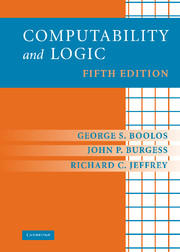Book contents
- Frontmatter
- Contents
- Preface to the Fifth Edition
- COMPUTABILITY THEORY
- BASIC METALOGIC
- 9 A Précis of First-Order Logic: Syntax
- 10 A Précis of First-Order Logic: Semantics
- 11 The Undecidability of First-Order Logic
- 12 Models
- 13 The Existence of Models
- 14 Proofs and Completeness
- 15 Arithmetization
- 16 Representability of Recursive Functions
- 17 Indefinability, Undecidability, Incompleteness
- 18 The Unprovability of Consistency
- FURTHER TOPICS
- Annotated Bibliography
- Index
9 - A Précis of First-Order Logic: Syntax
Published online by Cambridge University Press: 05 June 2012
- Frontmatter
- Contents
- Preface to the Fifth Edition
- COMPUTABILITY THEORY
- BASIC METALOGIC
- 9 A Précis of First-Order Logic: Syntax
- 10 A Précis of First-Order Logic: Semantics
- 11 The Undecidability of First-Order Logic
- 12 Models
- 13 The Existence of Models
- 14 Proofs and Completeness
- 15 Arithmetization
- 16 Representability of Recursive Functions
- 17 Indefinability, Undecidability, Incompleteness
- 18 The Unprovability of Consistency
- FURTHER TOPICS
- Annotated Bibliography
- Index
Summary
This chapter and the next contain a summary of material, mainly definitions, needed for later chapters, of a kind that can be found expounded more fully and at a more relaxed pace in introductory-level logic textbooks. Section 9.1 gives an overview of the two groups of notions from logical theory that will be of most concern: notions pertaining to formulas and sentences, and notions pertaining to truth under an interpretation. The former group of notions, called syntactic, will be further studied in section 9.2, and the latter group, called semantic, in the next chapter.
First-Order Logic
Logic has traditionally been concerned with relations among statements, and with properties of statements, that hold by virtue of ‘form’ alone, regardless of ‘content’. For instance, consider the following argument:
(1) A mother or father of a person is an ancestor of that person.
(2) An ancestor of an ancestor of a person is an ancestor of that person.
(3) Sarah is the mother of Isaac, and Isaac is the father of Jacob.
(4) Therefore, Sarah is an ancestor of Jacob.
Logic teaches that the premisses (1)–(3) (logically) imply or have as a (logical) consequence the conclusion (4), because in any argument of the same form, if the premisses are true, then the conclusion is true.
- Type
- Chapter
- Information
- Computability and Logic , pp. 101 - 113Publisher: Cambridge University PressPrint publication year: 2007



